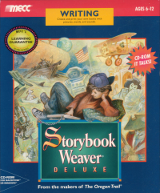Storybook Weaver
| Storybook Weaver | |
|---|---|
 |
|
| Developer(s) | MECC |
| Publisher(s) | MECC |
| Platform(s) | PC (Windows, Macintosh) |
| Release date(s) | 1994 (original and Deluxe versions) 2004 (CD-ROM rerelease of the Deluxe version) |
| Genre(s) | Educational |
| Mode(s) | Single player |
Storybook Weaver is a 1994 educational game released on floppy disk for the Apple Macintosh, aimed at children aged 6–12. An updated version, Storybook Weaver Deluxe, was released for Windows and Mac computers and featured much more content than the original. Both versions were released by MECC who also created The Oregon Trail, another educational game. The Deluxe version was made available for both home and school environments. A Teacher Resource CD for the software included lesson plans and user guides.
Storybook Weaver is a program that is intended to enable and motivate children to easily create their own stories on a computer. The most noticeable feature of the game is the sizable space allowed for illustrations on each page of a story. The game offered hundreds of backgrounds, objects and characters that could be selected from easy-to-use categories and placed anywhere on the page through a simple click-and-drag process. Backgrounds in the original featured mostly natural, outdoor locations, with which players could switch between day, night, dawn and dusk effects on the landscape. Users could piece together items such as walls and floors to create indoor settings for stories.
The graphical objects offered in the software included food, furniture, vehicles, vegetation, housing, floors, doors, walls, weather effects, natural landscape features and so on. The characters which could be placed in a story included humans, animals and make-believe people from fairytales and classic mythology. There were many human characters of various nationalities, most of which had several positions to choose from, including standing, running, sitting and sleeping. Fantasy characters included fearsome dragons, hobbits, fairies, giants, ghosts, Greek mythological creatures and magical beings such as sorcerers and witches such as Baba Yaga. Any object could be creatively manipulated to produce various effects, through flipping objects through various angles or modifying colour, size and shape in a paintshop-type program. For example, a puddle of water could be turned red to represent a pool of blood.
...
Wikipedia
